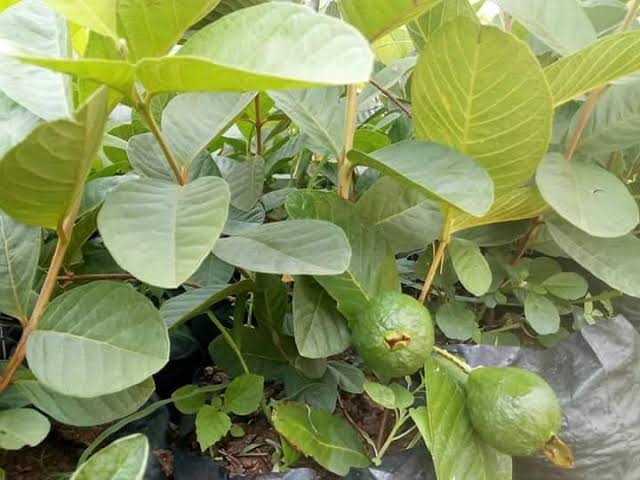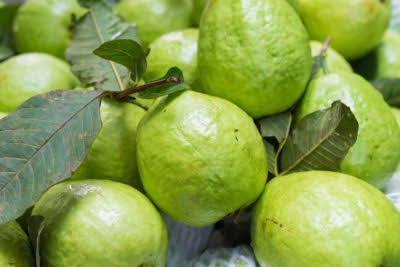Guava farming is a very lucrative business, due to the economic value of their fruits, leaves and other tree parts. The leaves of guava are highly medicinal and the fruits can be eaten raw or used for fruit juice. Other uses are; for flavor, beverages, ice cream, candies, deserts etc.
It can be grown everywhere in the world and are said to be the fruit of the tropics. Guava just like Strawberry Farming requires less labour and little management for great results.
In Nigeria the number of quava farmers going into commercial guava farming are very few. Many people want to go into ,Orange Farming mango farming, avocado farming etc” You see them rushing into something that may experience glut. Do you know that establishing guava plantation and maintaining it requires less work and capital compare to other economic trees.
The purpose of this post is to encourage entrepreneurs to invest in guava farming because with little effort comes high yield. Go to the market you will hardly see guava fruits to buy if eventually you find them, the price is always higher than other fruits in its own category.
Guava contains Calcuim, phosphorus and plenty of Vitamin C. If you are asking the question how to plant guava for profit, I will tell you that it is not difficult like orange, Apple and the rest. But it requires the use of new technique in other to achieve success.
These techniques involves the use; of guava improved variety, pruning,the number of seedlings to raise and the distance to give to them, canopy management and general farm management because it will encourage higher fruit production.
Guava has many names but guava is the popular name. Other names are; Kuawa, Guayabo, Goiabira, Red Guava etc. Guava plants are majorly grown from seeds, the germination is straight forward no condition attached. It is just like planting pepper seeds.

GUAVA DESCRIPTION
Guava is said to originate from Mexico and South America, they belong to Myrtaceae family and the scientific name is Psidium. Their fruits are either oval in shape or round depending on the variety.
It ranges from 5cm-10cm in length. Apart from planting guava in open field you can also plant them in pottery, green houses, poly houses and at the back of your house. Indians are the highest producer of guava followed by China, Thailand, other countries are; Mexico, Phillipines, Bangadash,Nigeria, Pakistan, Indonesia etc.
GUAVA VARIETY
There are many varieties of guava and they are classified according to their colour; red, pink, red, green. Some of the varieties are:
- White Malaysian
- Ruby Supreme,
- Vietnamese
- Purple Malaysian
- Turnbull White
- Giant Bangkok
- Mexican Cream
- Apple guava
- Nagpur seedless
LAND PREPARATION
Clear the land and plough the soil very well. Apply farmyard manure during land dressing. It could be animal dung such as; cow dung, goat dung, pig dung, sheep dung etc. Or compose manure also known as green manure.
Dig holes of 1 meter each. Mix manure with top soil and fill the pit.
Although it can be grown anywhere in the globe both in the tropics and subtropics under different soil types and climatic conditions. but they perform optimum in the tropics.
Too much of high temperature is not good for guava during flowering stage and fruit setting because it will result in fruits dropping.
Guava trees are hardy in nature and can be grown in a clayey soil, sandy soil and deep loamy soil. For optimum yield avoid water log farmland in other to guide against root rot. Use a well drained loamy soil rich in organic manure with a PH of 5.0-7.0
PROPAGATION IN GUAVA FARMING
Unlike many other economic trees that thrive well through vegetative propagation guava are mostly propagated through quality seed cultivation. Because it will produce quality and large quantity of fruits with different shape and sizes.
Vegetative propagation can be done through cutting, air layering, budding and grafting method. The best method for commercial guava farming is Air-layering. For rapid multiplication of plant use stooping or mound layering on nursery beds.
Dig pit of 75cm x 75cm x75cm before raining season. Spacing in guava farming depends on the cultivar, for commercial guava farming let the spacing bev5m x 5m or 6m x 6m.
It will accommodate 275 plants in a hectare. You can use a spacing of 3m x 3m if you are thinking of high density guava farming. A hectare will accommodate 550 seedlings and a yield of more than 150kg for each plant. Fruit yield of about 120kg of fruits per unit can be gotten from 6m x6m spacing.
IRRIGATION
Irrigation is very important in guava farming and can only be done when there is drought or shortage of water. During raining season, irrigation may not be necessary unless otherwise.
In that case watering should be done frequently during growing and production stages. Irrigate the farm immediately after transplanting the seedlings for quick establishment.
Drip irrigation is the most accepted method because it will help in the production of quality and large yield of guava fruits. Watering should be done moderately in other not to allow water stagnation. During fruiting apply water to a guava plant 20-30 liters in a day.
FERTILIZER APPLICATION IN GUAVA FARMING
It can grow well with organic fertilizer only but you can also use inorganic fertilizer in your guava farm.
Spray copper sulphate (CuS04) @ 0.2 – 0.4 % , it will enhance plant growth, fruit production, quality, and the quantity in fruit yield.
PEST AND DISEASE IN GUAVA FARMING
There are several pest that attack guava plant such as; Fruit borers, Beetle borers, Caterpillars, Bugs, Gall flies, Mite, Scale insect. Use pesticides to attack them.
Diseases in guava plant are scarce but not completely absent. Here, are some guava diseases; Nematodes, Anthracnose, Brown blight. Use neem oil, plant resistant variety, maintain good cultural agronomy management.
Birds are predators that will consumed your ripe or overly ripe guava, the antidote is to harvest your ripe guava on time. Ants are also a major challenge.
WEEDING
Weeding can be done 3 times a year in the early growing stage, but can be twice after some years to 2 times. As we know weed is not good for any crop so also it is not good for guava.
Weed can reduce the quality and quantity of the fruits. It will slow down growth and production. Always weed on time or use herbicide to kill grasses and other weeds. But care must be taken in other not to destroy the plant.
HARVESTING
Hybrid guava variety, fruits and mature faster than the traditional guava plant. Grafted, budded and layered guava plants produce fruits between 2 to 2 and half years.
Guava plant raised from seeds (seedling) starts fruit production within 4 years of planting. Fruits will be less at the starting but keeps increasing with years then by 8 years they start bearing heavily.
Pluck fruits when matured manually or by the use of hand cutter. Maturity time depends on the variety. Guava fruit will change colour from green to yellow when matured.
In some varieties the colour will only change from deep green to light green. Don’t allow it to over ripe on the tree because it will not last long after harvest neither can it be preserved.
Guava fruit can stay for 2-3 weeks before getting spoilt. Harvest fruits when they are still very strong not when soft. Care must be taken not to rub guava on any hard surface or allow them to fall on the ground during harvest.
This is because, rough handling and causing of wound (abrasion) will affect the quality of the fruit thereby reducing market value
A hectare can yield more than 25 tones of guava . Yield will depend on the variety, method of propagation and management practices. Grafted guava plant will produce more than 300kg of fruits while the ones grown from seed will be about 100kg per guava plant.

MARKETING
Sell to market traders, fruit vendors, fruit juice companies etc. many fruit juice companies are looking for where to buy guava in a large quantity. You don’t see guava in the market like other fruits because it is hardly enough for these companies.
You can add value to your guava business by processing the fruit to other products.
USES OF GUAVA LEAVES
- Diarrhea Treatment. Guava leaves contain anti-bacterial component that fights disease. And can treat diarrhea!
- Heart Disease Treatment. The leaves of quava contains Quercetin that helps reduce oxidativs stress and heart strokes.
- Prevent Cancer. Guava leaves contain antioxidants
- Guava leaves are use in stomach Ulcers Treatment The leaves contain the certain elements called saponin, flavonoid, and volatiloill. They combine to tackle ulcer.
- Glowing Skin especially for women, the leaves of guava when taken daily will keep the skin fresh. It can be process and added to cream for skin moisterization.
- Good for male fertility treatment. This is because it increases a man’s spermatozoa.
- A good treatment for cough. The leaves of guava when squeeze and fluid consumed helps to clear the lungs.
- It helps in preventing bad breath and mouth odour. A good recommendation from dentist.
If this post was useful to you, Please follow us on Facebook and Twitter. Use the comment box for your questions and get a prompt response and don’t forget to subscribe to our newsletter below, just enter your name and email address.

